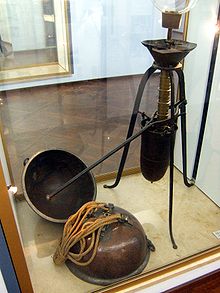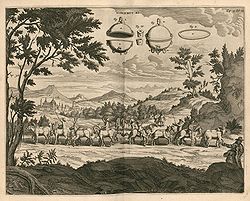- Magdeburg hemispheres
-
The Magdeburg hemispheres are a pair of large copper hemispheres with mating rims. When the rims were sealed with grease and the air was pumped out, the sphere contained a vacuum and could not be pulled apart by teams of horses. The Magdeburg hemispheres were designed by German scientist and mayor of Magdeburg,[1] Otto von Guericke in 1656 to demonstrate the air pump which he had invented, and the concept of atmospheric pressure. The first artificial vacuum had been produced a few years earlier by Evangelista Torricelli, and had inspired von Guericke to design the world's first vacuum pump, which consisted of a piston and cylinder with one-way flap valves. The hemispheres became popular in physics lectures as an illustration of the power of air pressure, and are still used in education. The original hemispheres are preserved in the Deutsches Museum in Munich.
Contents
Overview
 Original Magdeburg hemispheres and von Guericke's vacuum pump in Deutsches Museum, Munich, Germany
Original Magdeburg hemispheres and von Guericke's vacuum pump in Deutsches Museum, Munich, Germany
The Magdeburg hemispheres, around 50 cm (20 inches) in diameter,[2][3][4][5] were designed to demonstrate the vacuum pump that von Guericke had invented. One of them had a tube connection to attach the pump, with a valve to close it off. When the air was sucked out from inside the hemispheres, and the valve was closed, the hose from the pump could be detached, and they were held firmly together by the air pressure of the surrounding atmosphere.
The force holding the hemispheres together was equal to the area bounded by the joint between the hemispheres, a circle with a diameter of 50 cm, multiplied by the difference in air pressure between the inside and the outside. It is unclear how good a vacuum von Guericke's pump was able to achieve, but if it was able to evacuate all of the air from the inside, the hemispheres would have been held together with a force of around 40 000 N (9 000 lbf),[6] equivalent to lifting a car or small elephant; a dramatic demonstration of the pressure of the atmosphere.
Demonstrations
Von Guericke's demonstration was performed on 8 May 1654 in front of the Reichstag and the Emperor Ferdinand III in Regensburg.[7] Thirty horses, in two teams of 15, could not separate the hemispheres until the valve was opened to release the vacuum. In 1656 he repeated the demonstration with 16 horses (2 teams of 8) in his hometown of Magdeburg, where he was mayor. He also took the two spheres, hung the two hemispheres with a support, and removed the air from within. He then strapped weights to the spheres, but the spheres would not budge. Gaspar Schott was the first to describe the experiment in print in his Mechanica Hydraulico-Pneumatica (1657). In 1663 (or according to some sources in 1661) the demonstration was given in Berlin before Frederick William, Elector of Brandenburg with 24 horses.
The experiment became a popular way to illustrate the principles of air pressure, and many smaller copies of the hemispheres were made, and are used to this day in science classes. Re-enactments of von Guerike's 1654 experiment are performed in locations around the world by the Otto von Guericke Society. On the 18th of March 2000, a demonstration using 16 horses was conducted in Great Torrington by Barometer World.
The experiment has been commemorated on at least two German stamps.
After learning about Guericke's pump through Schott's book, Robert Boyle worked with Robert Hooke to design and build an improved air pump. From this, through various experiments, they formulated what is called Boyle's law, which states that the volume of a body of an ideal gas is inversely proportional to its pressure. Soon the ideal gas law was formulated.
References
- ^ "Guericke, Otto von". Encyclopedia Britannica, 11th Ed.. 12. Cambridge Univ. Press. 1910. pp. 670. http://books.google.com/books?id=GFAEAAAAYAAJ&pg=PA670.
- ^ Hablanian, M. H.; Hemeon, C. H. (2003). "Comments about Magdeburg hemispheres reenactment". 50 years of the AVS. American Vacuum Society. http://www2.avs.org/historybook/links/magden.htm.
- ^ Nave, C.R. (2000). "Original Magdeburg Hemispheres". Hyperphysics. Dept. of Physics and Astronomy, Georgia State Univ.. http://hyperphysics.phy-astr.gsu.edu/Hbase/Kinetic/pmdg.html.
- ^ "Magdeburg hemispheres". Multimedia Catalogue. Institute and Museum of the History of Science, Florence, Italy. 2006. http://brunelleschi.imss.fi.it/museum/esim.asp?c=500014.
- ^ Hall, Edwin H.; Bergen, Joseph Y. (1903). A Textbook of Physics, 3rd Ed.. New York: Henry Holt & Co.. pp. 52. http://books.google.com/books?id=szoAAAAAYAAJ&pg=PA52&dq=Magdeburg+hemispheres.
- ^ Calculated using a diameter of 0.5 m with atmospheric pressure; since air pushes in from both hemishperes, we have 2 * P0 * pi * r^2, where P0=air pressure; r=cross-sectional radius of a hemisphere. Due to the inefficiencies of the vacuum pump, the artificial vacuum was likely much weaker.
- ^ "Von Guericke, Otto". Encyclopaedia Britannica, 11th Edition. 9. The Encyclopaedia Britannica Co.. 1910. p. 670. http://books.google.com/books?id=GFAEAAAAYAAJ&pg=PA670&.
- "The Magdeburg hemispheres". Masterpieces from the Deutsches Museum. http://www.deutsches-museum.de/sammlungen/ausgewaehlte-objekte/meisterwerke-i/halbkugel/. Retrieved June 27, 2005.
- "The Magdeburg hemispheres". The Draft Horse Journal. http://www.drafthorsejournal.net/summer2004/feature.htm. Retrieved October 31, 2006. published in print Summer 2004.
External links
Categories:- Physics experiments
- Historical scientific instruments
- Magdeburg
Wikimedia Foundation. 2010.


